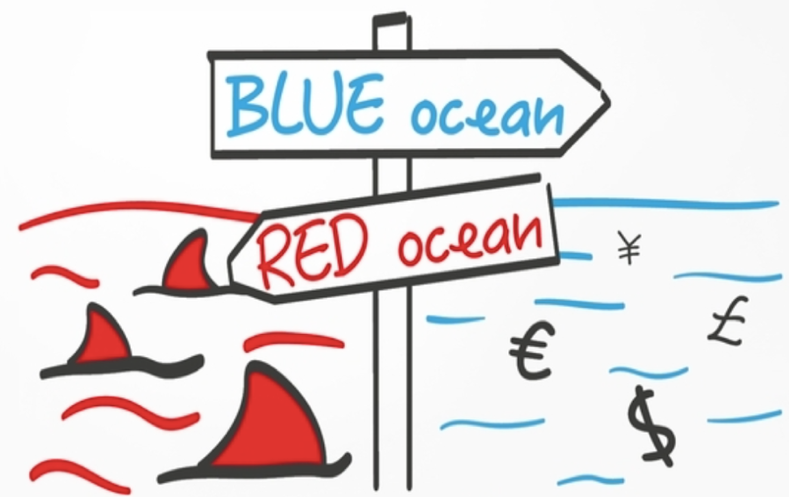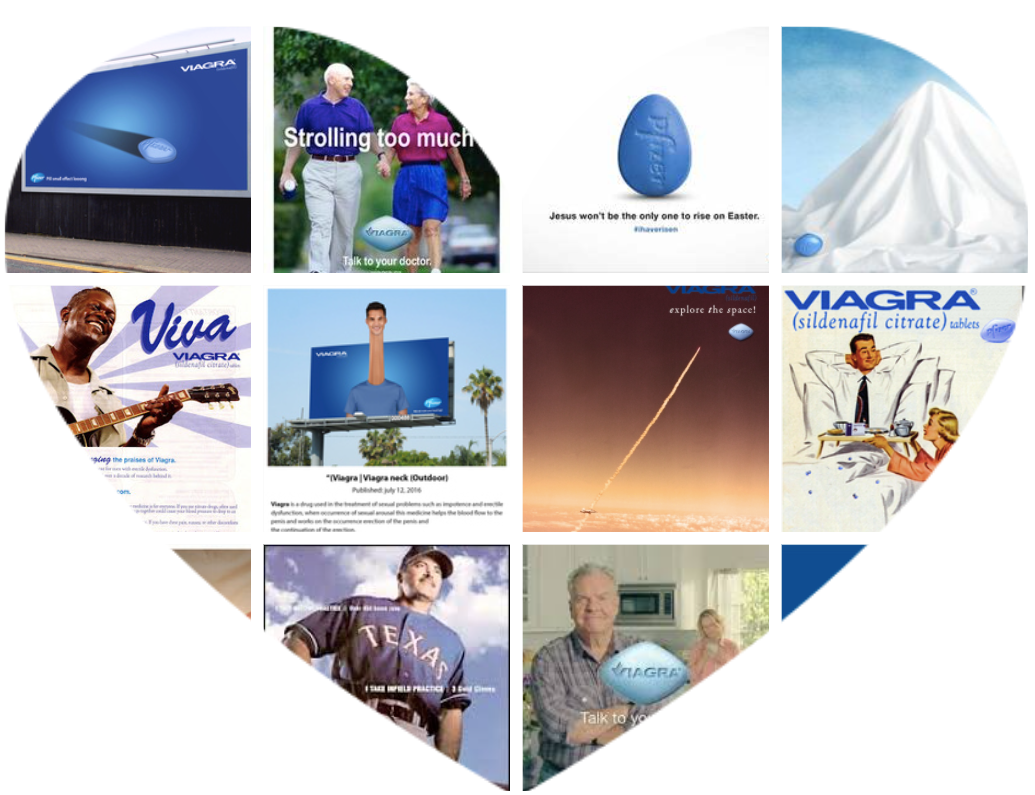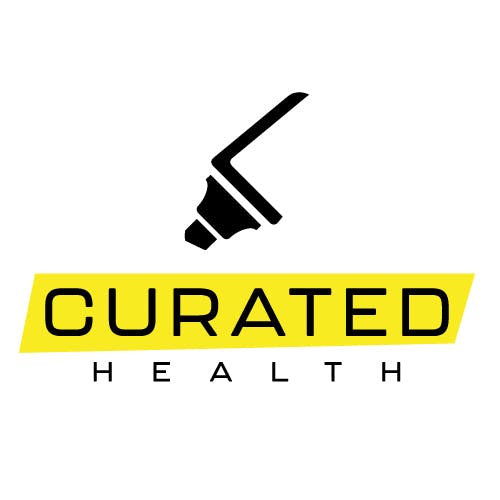The marketing strategy of an exciting discovery.
Viagra is one of the most popular drug brands in the world — so popular that it quickly entered pop culture. 3 years after its launch, Pfizer became the 5th most profitable company in the world. It generated annual revenues of about 2 billions for years… until the expiration of its patents in the 2010s. And yet, the success of Viagra was a risky bet.

An ocean of blue pills. From Getty.
Viagra treats erectile dysfunction (ED) and pulmonary arterial hypertension (but that’s not what we are here to talk about today, is it?). ED is the inability to get or keep an erection strong or long enough to have sexual intercourse. This condition is a real embarrassment for sufferers who are confronting social expectations and shame, including when looking to get treated. Yet, Pfizer managed to make these embarrassed patients go to their doctors and ask for the blue pill.
Let’s see how.
Blue and Red OceansWhen I started my training at INSEAD, not 2 days passed before I heard of the blue ocean strategy, developed by INSEAD professors: W. Chan Kim and Renée Mauborgne.
In a few words, it is a concept that combines strategy, marketing and value innovation. According to the authors, strong growth and high profits should be generated by creating new demand in a strategic space. Innovation (on a product, service, and so on) must create and increase value for customers and, at the same time, reduce or eliminate product features that are less valuable to the current or future market.
In this metaphor, red oceans are known marketplaces where existing companies of clearly defined sectors fight for growth, usually thanks to differentiation or lowering costs. The fierce competition results in bloody oceans. Businesses that swim in blue oceans can enjoy plenty of opportunities for rapid growth and profits as the market place is still unexplored and competition is irrelevant.

Image from Blue Ocean Strategy Concept
Now, how is that relevant to Viagra?
Bear with me.
When life gives you blue lemons, make blue lemonade!In the 90’s, Pfizer completed several clinical trials for “sildenafil citrate” (aka Viagra), a new chemical entity created to treat high blood pressure and angina, but none of them showed any positive outcomes.
A clinical trial is not a clinical trial without adverse effects. But some adverse effects are more unexpected (and fortunate) than others… Soon enough, patients reported having erections after taking the drug. Erection don’t go unnoticed, yet the link with the drug is not that obvious and only appeared when ED sufferers reported the very same “adverse” effect. The growing reports finally drew Pfizer’s scientists’ attention. At about the same time, unrelated academic investigations were disclosing insights about the biology involved in the erection process. Studies showed that sildenafil can increase muscle relaxation in the penile region which results in a higher blood flow in the area and helps in producing an erection. Further explorations were thus led by Pfizer teams. Eventually, sildenafil citrate became Viagra.
Life sciences and pharma are well acquainted with serendipity, but this finding is quite unique.
How Pfizer created a blue oceanSome medical conditions are associated with social stigma. The taboo is often exacerbated by a myriad of over-the-counter (OTC) miracle antidotes, whose mediocre marketing push patients to hide even more. Male impotence is one of those conditions. And it was impossible to treat it as you can’t treat a secret.
The marketing of Viagra offers valuable insights for marketers in pharma and beyond.
1️⃣ Brand the disease and market the treatment.
Pfizer’s teams rapidly realised that the perception of “impotence” would limit the drug’s impact. Pfizer thus redefined the embarrassing secret by eliminating the stigma surrounding it.
First, the name. You’re certainly familiar with the following words: AIDS, GERD, COPD, ADHD or even COVID-19. Medical language is filled with acronyms. Impotence should have its own: erectile dysfunction, also known as E.D. A discreet, easy and effective password. Perfectly suited for direct-to-consumer promotion and also to ease the initiation of the difficult conversation with the doctor. The two letters empowered men that suffered in silence.
Not only did the term ‘erectile dysfunction’ and its acronym ED changed the focus of the condition from being associated with lack virility (and whatnot) to a physical/biological bug, but Pfizer also showed millions of patients that the broken biological process is reversible — the disease is treatable.
Rebranding of impotence was one thing, convincing physicians to bring the topic on the table was another. Healthcare professionals were more concerned about serious diseases like diabetes and hypertension. So be it. “Doctor, recent studies show that ED apparition correlates with blood circulation problems and is a good predictor of cardiac events in the type of patients you treat. Why don’t you start asking about ED?” (By the way, we have the perfect solution for that.)
Medicalisation and sensitisation are not enough. The company worked hard and invested a lot of money to make ED look like a common condition through its marketing communication.
“Half of men over 40 are affected with ED”.
“4.3 million men in the UK experience erectile problems. That’s a lot of men. That’s enough men to fill every major British football stadium.”
Let’s have a closer look at their advertising campaign
2️⃣ Manage your advertising campaign like a science project.
Everyone knows about Viagra. How did Pfizer come up with such great ads that resonated with its target audience?
The company followed the same framework that it would for drug discovery, its core activity. Just like R&D screened thousands of different molecules to find the one that makes a difference, they did the same with their advertising : develop a plethora of ideas and prune it to the one killer communication.

From suggestive photos to grandpa-featuring ads, Pfizer tried countless approaches until they found The One: having a woman endorse a man to his doctor about Viagra… It worked like a charm.
3️⃣ Invite your product in the daily life of the user.
Back in 1998, Viagra was a thing, even before it was in the market. You could hear about it on TV, read about it in the newspaper, talk about it at the next dinner party. It was everywhere. Pfizer introduced it as something we have all been waiting for.

Time. May 4th, 1998.
But Viagra needed a face. That’s when Bob Dole, a 27 year-long American senator and former presidential candidate of the USA, came in. Pfizer wasn’t the 1st to use celebrity testimonials for disease awareness campaigns. However, it pioneered in the era of the celebrity spokesperson. Bob Dole appeared in numerous commercials, TV live shows and interviews. It brought a revolution in the way such stars participated in pharmaceutical campaigns.
Bole Dole about ED. The little blue pill was only discreetly hinted.
Do you think that, if Viagra was launched in 2022, Pfizer would have hired Instagram influencers? #blueisthenewgoto
Eventually, other stars and athletes endorsed the “vitamin V”.
In July 1999, in the new episode of the famous TV show, Sex and the City, Samatha dates Alderman, a rich guy who takes the “blue diamond”. In the next season, Samantha takes some herself to upgrade her sexual experiences. Viagra was in your living room.
An ocean never stays blue very longBy the time patents approached their expiry dates, competition for Viagra stepped up with new entrants: Cialis (Eli Lilly) and Levitra (Bayer and GSK). And it was visible quarter after quarter on revenue figures.

Evolution of Viagra’s revenue in million USD, from blue ocean to red ocean. Data come from Pfizer’s annual financial reports.
Luckily, Pfizer was prepared for the inevitable reddening of the market. It set up a few barriers to offset competition and protect its market share from the upcoming generic erosion, including:
Launching a generic version of Viagra and partnering with two leading international generic manufacturers (Mylan and Teva).
Reshaping the package: increasing of the number of pills per pack, introduction of single pill packs, invention of the chewable Viagra…
Launching an OTC version in the UK.
Selling it online, directly to patients. It was a first for Big Pharma and it created a whole new blue ocean for the blue pill.
Viagra may no longer be the financial success it once was. Still, thanks to a perfectly mastered marketing strategy, its impact on two decades of destigmatisation of ED and sexual failures has been incredible. Pfizer created a lifestyle enhancement drug and showed that when companies are willing to challenge the boundaries of their industry, they can create a new market space, free of sharks.


